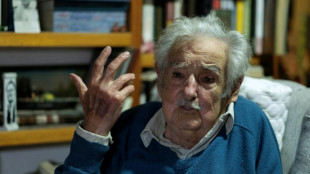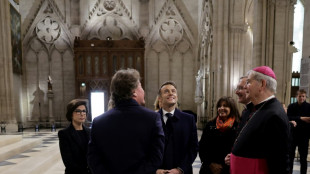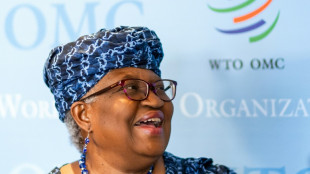
-
 Trudeau in Florida to meet Trump as tariff threats loom: media
Trudeau in Florida to meet Trump as tariff threats loom: media
-
Hunter shines as Hawks top Cavs again

-
 Southampton denied shock Brighton win by dubious VAR call
Southampton denied shock Brighton win by dubious VAR call
-
Alarm over high rate of HIV infections among young women, girls

-
 Swiss unveil Euro 2025 mascot Maddli
Swiss unveil Euro 2025 mascot Maddli
-
Bears fire coach Eberflus after latest agonizing NFL defeat

-
 Rallies mark one month since Spain's catastrophic floods
Rallies mark one month since Spain's catastrophic floods
-
Arnault family's Paris FC takeover completed

-
 Georgian police stage new crackdown on pro-EU protestors
Georgian police stage new crackdown on pro-EU protestors
-
'We're messing up:' Uruguay icon Mujica on strongman rule in Latin America

-
 Liverpool dealt Konate injury blow
Liverpool dealt Konate injury blow
-
Van Nistelrooy appointed Leicester manager

-
 Verstappen brought back to earth in Doha after F1 title party
Verstappen brought back to earth in Doha after F1 title party
-
Global wine output to hit lowest level since 1961

-
 Norris boosts McLaren title hopes with sprint pole
Norris boosts McLaren title hopes with sprint pole
-
Big-hitting Stubbs takes satisfaction from grinding out Test century

-
 Romania recounts presidential ballots as parliamentary vote looms
Romania recounts presidential ballots as parliamentary vote looms
-
French skipper Dalin leads as Vendee Globe passes Cape of Good Hope

-
 Chelsea not in Premier League title race, says Maresca
Chelsea not in Premier League title race, says Maresca
-
Brazil's Bolsonaro aims to ride Trump wave back to office: WSJ

-
 France requests transfer of death row convict held in Indonesia: minister
France requests transfer of death row convict held in Indonesia: minister
-
'Mamie Charge': Migrants find safe haven in Frenchwoman's garage

-
 Iconic Uruguayan ex-leader hails country's swing left as 'farewell gift'
Iconic Uruguayan ex-leader hails country's swing left as 'farewell gift'
-
Thousands rally in Georgia after violent police crackdown on pro-EU protesters

-
 Shared experiences make Murray 'perfect coach', says Djokovic
Shared experiences make Murray 'perfect coach', says Djokovic
-
Iran, Europeans to keep talking as tensions ratchet up

-
 Inflation-wary US consumers flock to 'Black Friday' deals
Inflation-wary US consumers flock to 'Black Friday' deals
-
France shows off restored Notre Dame after 'impossible' restoration

-
 South African bowlers strike after Sri Lanka set big target
South African bowlers strike after Sri Lanka set big target
-
Namibia reopens polls after election chaos in ruling party test

-
 Georgia police arrest dozens in clashes with pro-EU protesters
Georgia police arrest dozens in clashes with pro-EU protesters
-
US stocks rise on Black Friday

-
 Leclerc on top for Ferrari in Qatar GP practice
Leclerc on top for Ferrari in Qatar GP practice
-
Jihadists, allies enter Syria's second city in lightning assault

-
 Amorim puts faith in Mount to turn around Man Utd career
Amorim puts faith in Mount to turn around Man Utd career
-
Guardiola will not 'run' from Man City rebuild

-
 Assisted dying campaigners, opponents rally at UK parliament
Assisted dying campaigners, opponents rally at UK parliament
-
Durable prop Healy set to carve name in Irish rugby history

-
 Macron unveils Notre Dame after 'impossible' restoration
Macron unveils Notre Dame after 'impossible' restoration
-
Traumatised Spain marks one month since catastrophic floods

-
 Yen rallies, euro up on rising inflation data
Yen rallies, euro up on rising inflation data
-
Attack-minded Spurs boss Postecoglou says: 'You'll miss me when I'm gone'

-
 Syria jihadists, allies shell major city Aleppo in shock offensive
Syria jihadists, allies shell major city Aleppo in shock offensive
-
Macron inspects 'sublime' Notre Dame after reconstruction

-
 Arsenal must be near-perfect to catch Liverpool, says Arteta
Arsenal must be near-perfect to catch Liverpool, says Arteta
-
Arrests, intimidation stoke fear in Pakistan's politics

-
 Showdown looms on plastic treaty days before deadline
Showdown looms on plastic treaty days before deadline
-
Ngozi Okonjo-Iweala: the WTO's trailblazing motivator

-
 WTO chief reappointed as Trump threat looms
WTO chief reappointed as Trump threat looms
-
US landmine offer to Ukraine throws treaty into 'crisis': campaign group


'Unspeakable horror': the attacks on Hiroshima and Nagasaki
The Nobel Peace Prize was awarded Friday to Nihon Hidankyo, a Japanese group of atomic bomb survivors who are advocating for "a world free of nuclear weapons".
The survivors are from Hiroshima and Nagasaki, two cities that the United States dropped nuclear bombs on in 1945 at the end of World War II.
Hiroshima was hit on August 6, 1945, killing 140,000 people. Three days later, another bomb was dropped on Nagasaki, killing around 74,000 people.
Here are some facts about the attacks:
- The bombs -
The first atomic bomb was dropped on the western city of Hiroshima by the US bomber Enola Gay.
The bomb was nicknamed "Little Boy" but its impact was anything but small.
It detonated about 600 metres (2,000 feet) from the ground, with a force equivalent to 15,000 tonnes of TNT.
Tens of thousands died instantly, while others succumbed to injuries or illness in the weeks, months and years that followed.
Three days later the US dropped a second bomb, dubbed "Fat Man", on the city of Nagasaki.
The attacks remain the only time atomic bombs have been used in wartime.
- The attacks -
When the bomb was dropped on Hiroshima, the first thing people noticed was an "intense ball of fire", according to the International Committee of the Red Cross (ICRC).
Temperatures near the blast reached an estimated 7,000 degrees Celsius (12,600 Fahrenheit), which burned human skin within a radius of about 3.5 kilometres (two miles).
ICRC experts say there were cases of temporary or permanent blindness due to the intense flash of light, and subsequent related damage such as cataracts.
A whirlwind of heat generated by the explosion also ignited thousands of fires that burned several square kilometres of the largely wooden city. A firestorm that consumed all available oxygen caused more deaths by suffocation.
It has been estimated that burn- and fire-related casualties accounted for more than half of the immediate deaths in Hiroshima.
The explosion generated an enormous shock wave that in some cases literally carried people away. Others were crushed to death inside collapsed buildings or injured or killed by flying debris.
"I remember the charred bodies of little children lying around the hypocentre area like black rocks," Koichi Wada, a witness who was 18 at the time of the Nagasaki attack, has said of the bombing.
- Radiation effects -
The bomb attacks unleashed radiation that proved deadly both immediately and over the longer term.
Radiation sickness was reported in the aftermath by many who survived the initial blasts and firestorms.
Acute radiation symptoms include vomiting, headaches, nausea, diarrhoea, haemorrhaging and hair loss, with radiation sickness fatal for many within a few weeks or months.
Bomb survivors, known as "hibakusha", also experienced longer-term effects including elevated risks of thyroid cancer and leukaemia, and both Hiroshima and Nagasaki have seen elevated cancer rates.
Of the 50,000 radiation victims from both cities studied by the Japanese-US Radiation Effects Research Foundation, about 100 died of leukaemia and 850 suffered from radiation-induced cancers.
The group found no evidence however of a "significant increase" in serious birth defects among survivors' children.
- The aftermath -
The twin bombings dealt the final blow to imperial Japan, which surrendered on August 15, 1945, bringing an end to World War II.
Historians have debated whether the devastating bombings ultimately saved lives by bringing an end to the conflict and averting a ground invasion.
But those calculations meant little to survivors, many of whom battled decades of physical and psychological trauma, as well as the stigma that sometimes came with being a hibakusha.
Despite their suffering and their status as the first victims of the atomic age, many survivors were shunned -- in particular for marriage -- because of prejudice over radiation exposure.
Survivors and their supporters have become some of the loudest and most powerful voices opposing the use of nuclear weapons, meeting world leaders in Japan and overseas to press their case.
In 2019, Pope Francis met several hibakusha on visits to Hiroshima and Nagasaki, paying tribute to the "unspeakable horror" suffered by victims of the attacks.
In 2016, Barack Obama became the first sitting US president to visit Hiroshima. He offered no apology for the attack, but embraced survivors and called for a world free of nuclear weapons.
C.Meier--BTB
